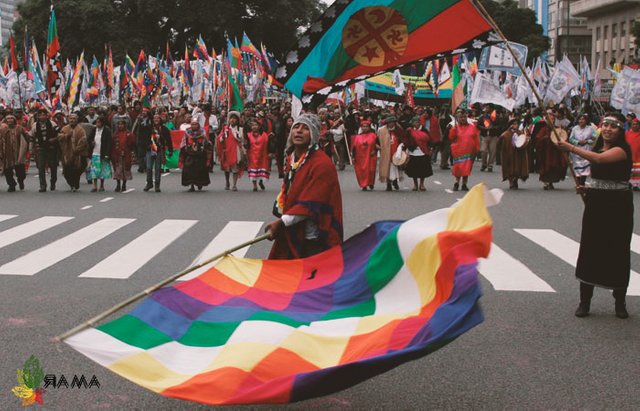Tribute to the wiphala

La motivación para esta publicación se debe a los echo posteriores a las elecciones presidenciales ocurrida en Bolivia hace unas semanas: específicamente las manifestaciones racistas en contra de las personas de origen indígenas de ese país, y el desprecio manifiesto por el símbolo de la bandera whipala.
The motivation for this publication is due to the events after the presidential elections that took place in Bolivia a few weeks ago: specifically the racist manifestations against the indigenous people of that country, and the contempt expressed by the Whipala flag symbol.

La whipala, aunque muy semejante a la bandera arcoíris del movimiento LGTB, no es la misma. Originariamente la bandera representaba la diversidad de los pueblos indígenas de los Andes, pero ahora vas mas alla, representado la diversidad cultural, de etnias y de formas de vida de todo el planeta, celebrando las formas vida particulares de cada comunidad y el valor que esta representa.
El origen de la wiphala, despierta fuertes polémicas, hay quienes lo atribuyen como símbolo de los pueblos más antiguos como la cultura Tiwuanaku, pero la gran explosión de la wiphala en la iconografía aymara acontece con las movilizaciones del sindicalismo campesino en la década de 1970 en Bolivia.
La wiphala es bastante más que la bandera y el emblema de la nación Andina y de los Aymara, es la representación de la filosofía andina, simboliza la doctrina del Pachakama (principio, orden Universal), y la Pachamama (madre, cosmos) que constituye el espacio, el tiempo, la energía y nuestro planeta, por eso el significado de la Wiphala es un todo. Actualmente, es símbolo de la resurrección de la cultura que fluyó de los primordiales Cuatro Estados del Tiwantinsuyo.
The whipala, although very similar to the rainbow flag of the LGBT movement, is not the same. Originally the flag represented the diversity of the indigenous peoples of the Andes, but now you go beyond, representing the cultural diversity, ethnicities and ways of life of the entire planet, celebrating the particular life forms of each community and the value that is It represents.
The origin of the wiphala, arouses strong controversies, there are those who attribute it as a symbol of the oldest peoples such as the Tiwuanaku culture, but the great explosion of the wiphala in Aymara iconography occurs with the mobilizations of peasant unionism in the 1970s in Bolivia
The wiphala is much more than the flag and emblem of the Andean nation and the Aymara, is the representation of the Andean philosophy, symbolizes the doctrine of Pachakama (principle, Universal order), and the Pachamama (mother, cosmos) that constitutes space, time, energy and our planet, that's why the meaning of the Wiphala is a whole. Currently, it is a symbol of the resurrection of the culture that flowed from the primordial Four States of the Tiwantinsuyo.

En el centro está atravesada por una franja de siete cuadrados blancos que simbolizan las Markas (comarcas) y Suyus (regiones), es decir la colectividad y la unidad en la diversidad geográfica y étnica de los Andes. También representa el principio de la dualidad, así como la complementariedad de los opuestos, por lo tanto unión de los espacios; y así la oposición complementaria o fuerza de la dualidad, es decir: fertilidad, unión de los seres y, por consiguiente, la transformación de la naturaleza y los humanos que implica el camino vital, y la búsqueda a la que éste nos impulsa.
Significado de los colores: Rojo: El planeta tierra. Naranja: Representa la sociedad y la cultura. Amarillo: Es la energía y fuerza. Blanco: El tiempo y la dialéctica. Verde: Representa la economía y la producción. Azul: Espacio cósmico, el infinito. Violeta: La política y la ideología
In the center it is crossed by a strip of seven white squares that symbolize the Markas (regions) and Suyus (regions), that is to say the collectivity and unity in the geographic and ethnic diversity of the Andes. It also represents the principle of duality, as well as the complementarity of opposites, hence union of spaces; and thus the complementary opposition or force of duality, that is: fertility, union of beings and, consequently, the transformation of nature and humans that implies the vital path, and the search to which it drives us.
Meaning of the colors:
Red: Planet Earth. Orange: Represents society and culture. Yellow: It is energy and strength. White: Time and the dialectic. Green: Represents the economy and production. Blue: Cosmic space, the infinite. Violeta: Politics and ideology

De esta manera me uno al llamado de izar la whipala en todas partes, como símbolo de resistencia y dignidad indígena
In this way I join the call to raise the whipala everywhere, as a symbol of resistance and indigenous dignity

Thank you!!
la Whipala somos todos, aguantando injusticias durante siglos.